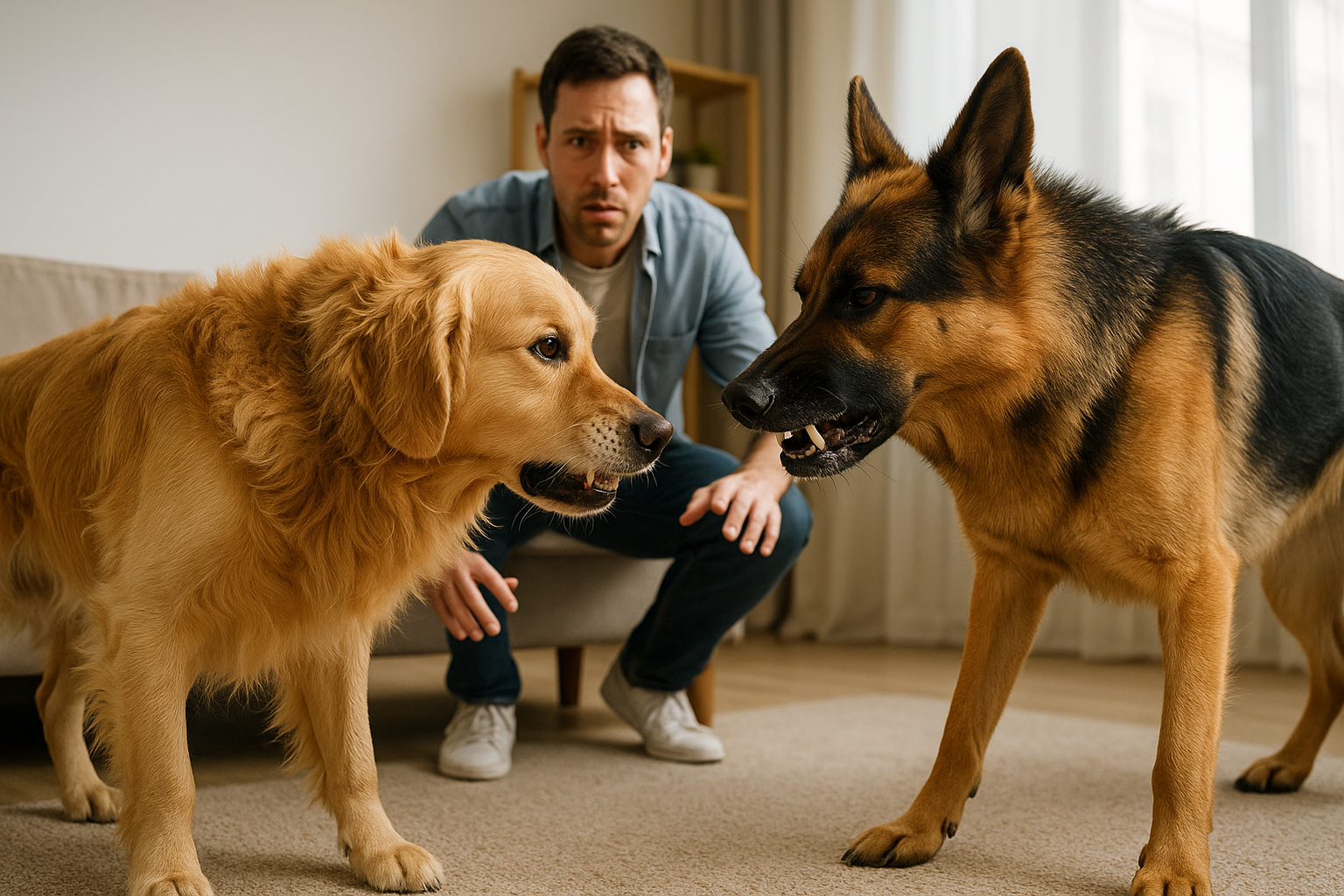July, 16, 2025 Posted by FXW Life
How to Stop Puppy Zoomies Indoors: Safe, Flexible Solutions
Picture this: You’ve just settled in after a long day, and suddenly your pup launches into a full-blown case of the zoomies – sprinting laps around the couch, knocking over a shoe rack, and sliding across the kitchen floor. Your heart is pounding as fast as your dog’s paws. “Help, my dog is out of control!” – take a deep breath.
You are not alone. Many of us have been exactly where you are, wondering if this is normal or if our dog is just crazy. (Spoiler: it’s normal!) In fact, there’s even a technical name for those frenetic puppy freak-outs: zoomies, also known as FRAPs (Frenetic Random Activity Periods).
And yes, they happen to a lot of dogs, especially rambunctious puppies. I remember the first time my own big goofy puppy, Rocky, got the zoomies – he nearly sent a lamp flying, and I was at my wit’s end. Sit tight, we’re going to talk about why dogs get these wild energy bursts, why it’s okay to feel overwhelmed, and a game-changing tool that can help. Let’s dive in with a warm hug and a promise: you’ve got this, and it will get better!

Understanding the Dog Zoomies (FRAPs) and Why They Happen
So “zoomies” or FRAPs, essentially, is an explosion of pent-up puppy energy that comes out as sudden, frantic running and playing.
Dogs get zoomies as a way to release energy or even relieve stress. Common triggers for zoomies include being alone and bored for a long stretch, getting super excited, or even just before bedtime when they realize the day is almost over. Have you noticed your pup zipping around late in the evening or right after a bath? Yup, those are classic zoomie moments. Puppies and young dogs tend to experience FRAPs the most, though older dogs might still surprise you with a wild run occasionally.
While zoomies are adorable (in a destructive kind of way) and a natural part of dog behavior, they can be problematic indoors. Tight spaces, hard furniture, and slippery floors mean a zooming pup can accidentally hurt themselves or knock over. It is advisable that you don’t try to physically stop your dog mid-zoomie – the frenzy will wind down on its own within minutes. Instead, focus on making the environment safe and giving your dog appropriate outlets for that energy. Adequate exercise, playtime, and mental stimulation throughout the day can help reduce the frequency of zoomies. But when those indoor sprints do happen, having a plan to protect both your pet and your home is key.

Dog Playpen 101: A Safe Space for Your Dog, Not a Cage
One of the best indoor solutions for managing a wild puppy is a dog playpen. If you’ve never heard of a dog playpen (many new pet parents haven’t), think of it as a play area fenced off just for your pup – kind of like a toddler playpen or a baby gate enclosure, but designed for dogs. Importantly, it’s not a harsh cage or punishment zone. In fact, a good playpen is more like your dog’s cozy den: a place where they can chill out, play with their toys, or snooze safely, giving you a much-needed break.
Playpens are not permanent shelters– they’re temporary safe zones. You might use a playpen when you can’t supervise your puppy for a little while (say, you’re cooking dinner or on a work call), or when they’re getting overly rambunctious and need a chance to settle down. By using a playpen, you’re preventing bad behaviors before they happen – no more coming back from a five-minute bathroom break to find the trash can toppled and its contents strewn about.

Practical Benefits from A Playpen: Peace of Mind for Both of You, Protecting Your Home and Aiding Dog Training
Peace of Mind for Both of You
Dogs, even the big goofy ones, appreciate having a space of their own where they feel secure. By introducing the pen in a positive way (with treats, toys, and praise), your pup will come to see it as a happy place to hang out. They can curl up for a nap in their bed or quietly chew a toy without you hovering or constantly telling them “no.” Often, puppies will willingly wander into their pen when they’re feeling sleepy or overwhelmed – it’s a sign they recognize it as a comfy retreat.
And for you, a pup parent, instead of feeling like a frazzled referee, you get to be a loving companion – playing with your pup when they’re out and relaxed, and getting guilt-free downtime when they’re in their safe space.
Protecting Your Home from Being Chewed Up
Beyond the emotional relief, a dog playpen comes with plenty of practical benefits for managing puppy mayhem. First and foremost, it protects your home and everything in it. Those expensive shoes by the door? Your toddler’s toys or the TV remote? No longer in danger of becoming chew toys. Instead of scolding your puppy for biting the couch cushions, you’re redirecting them to play with their own toys in a safe zone. Fewer opportunities for mischief means fewer messes and accidents for you to clean up later.
A Great Helper in Home Training
Using a playpen can also speed up house training and obedience training. Dogs thrive on consistency, and a pen helps establish a routine. For instance, many owners place a puppy pad or take the puppy straight to the yard after releasing them from the pen, reinforcing where potty is supposed to happen.
Training basics like sit, stay, and quiet time can be reinforced with a playpen as well. You can gently guide your pup into the pen with a treat, say “quiet time” or a cue, and reward calm behavior inside. This teaches them that settling down is a positive, rewarded behavior. In a controlled, enclosed space free from household distractions, puppies often learn to focus better on you and the training at hand.
Flexible and Big-Breed Friendly: Finding the Right Playpen for Your Dog
You might be wondering, “Will a playpen even work for my dog? He’s a big breed dog with energy for days!” The answer is yes – you just need the right kind of playpen.
So, when shopping for a playpen, look for features that specifically suit big breed puppies:
✅ What to Look for in a Dog Playpen:
✔️ Sturdy Construction Big dogs = big power. Choose heavy-duty metal or reinforced plastic that won’t wobble or collapse if your dog leans or bumps into it.
✔️ Adjustable Size & Shape Look for modular panels you can connect and reconfigure into squares, rectangles, or corners. This lets you adapt the setup to your room — or grow it as your puppy does.
✔️ Height Matters For larger or jumpy breeds, go for taller panels (at least 36–48 inches). Bonus: Some pens offer optional mesh tops to prevent climbers from escaping.
✔️ Secure Latching Gate A latched or locking gate makes entry easy for humans — and hard for clever pups to outsmart.
✔️ Indoor & Outdoor Friendly Many great pens work both inside and outside. Look for anti-slip feet for hard floors and ground stakes for outdoor stability.
✔️ Portable & Easy to Store Folding panels or quick-clip designs let you tuck the pen away or bring it on trips with ease.
✔️ Space for Essentials Ensure it’s roomy enough to fit your dog’s bed, water bowl, and a few toys — especially for larger breeds who need room to stretch and settle.

Training + The Right Tools: A Winning Combo
A dog playpen is a powerful tool, but it works best when paired with consistent training, care, and structure. Here’s how to make the most of both:
🐾 Combine Training + Playpen Use
- Teach basic commands like sit, stay, down, and especially settle — which you can use when guiding your dog into the playpen.
- Practice calm behavior in the pen by rewarding your dog for relaxing quietly inside it.
- Use the pen as part of your daily routine — not a last resort when you're frustrated.
🐾 Keep Your Dog Engaged & Balanced
- Ensure plenty of daily exercise and play outside the pen — a tired pup is a calmer pup.
- Add mental stimulation inside the pen: puzzle toys, chew treats, and rotating toys help reduce boredom.
- For big breed dogs, include energy-burning activities like backyard agility, fetch, or doggy playdates.
🐾 Use the Pen Consistently & Positively
- Make the pen part of a predictable schedule:
→ Morning: quiet time after breakfast
→ Evening: chill zone while the family eats or winds down
- Over time, your pup will rely on the pen less as they mature and learn boundaries.
🐾 Keep the Playpen a Happy Place
- Avoid using it as punishment — always associate the pen with treats, calm, and good vibes.
- Celebrate when your dog chooses to go in on their own — it means they see it as a safe den.
🐾 And for You: Give Yourself Grace
- Not every day will be perfect. Puppy parenting is messy, joyful, and hard.
- It’s okay to step outside for a breather. That’s why the pen is there — so you can reset while your dog is safe.
Remember: The playpen is a temporary support, not a forever solution. It helps your pup learn how to self-regulate — and helps you stay sane while they do.

From Zoomies to Zen: Creating Calm with the Right Tools
If your pup’s turning your home into a racetrack, know this — you’re not alone, and you’re not doing it wrong. Zoomies are normal. What helps is structure: a bit of exercise, some play, and then quiet time in a cozy dog playpen where they can settle and recharge.
Many first-time dog owners have found peace (and intact furniture) by using a playpen as part of their daily routine. With patience, training, and love, those wild moments will become fewer — and one day, you’ll smile at the memory of your zoomie-filled pup. Hang in there — you’re doing great.









